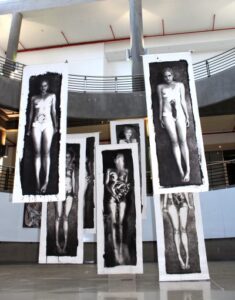Heidi Mielke, “The Sentinels Project,” 2013-present
A contribution to my blog by art historian Pamela Allara

Heidi Mielke is a visual artist who is the education manager at Artist Proof Studio in Johannesburg. In the” Sentinels” series of Vandyke prints on cloth, she addresses the concept of the female nude in art from a political/activist perspective. The prints are life size, all posed by the artist.
When one brings to mind the image of the female nude in Western art history, for instance from Titian to Manet, one sees a reclining figure, often on a bed, gazing alluringly out at the viewer, ready to be mounted. Although feminist artists challenged that ‘one-dimensional’ portrayal of the female nude by presenting more realistic, less idealized images from the 1970s on, often these ‘naked’ nudes remain prone or seated. I am thinking in particular of Alice Neel’s portrait nudes, including her own from 1980. Of her many nudes, only her 1934 portrait of her naked 10-year-old daughter Isabetta is standing. But there is one exception: the well-known South African artist Marlene Dumas, whose standing nudes, either in ink or oil paint, are unabashed in their nakedness—indeed they appear to celebrate it. I assume that Mielke knows the work; certainly, she appears to be building on it. Nonetheless, I did not have Dumas in mind when I saw Miele’s images in her talk. It was my own long-standing expectations of the female nude that caused me to be taken aback by Mielke’s “Sentinels Project”. The nudes are standing! In that posture they become confrontational, but what precisely may that mean?
Mielke describes the project in detail on her website, https://heidimielke.com, I will summarize some of her main points. In her prints and paintings, the artist uses her own body to perform. She present us with examples of violence against women, which, she argues, still predominatein the ‘new’ South Africa. She began the series in 2013 after learning of the violent rape and murder of a 17-year-old woman, Amene Booysen, who was disemboweled in the process. That horrific event propelled her toward an activist art.
Mielke continued the series in 2016 during the perpetrator’s trial. Her aim has in general been to provide a heightened consciousness of social justice issues in a patriarchal country that has failed to overcome the discrimination and victimization of women. After her masters exhibit in the Women’s Jail at the Constitutional Court in 2015, she began to incorporate newspaper clippings and drawings on the women’s bodies transforming them into landscapes of violence. Should such violence simply be accepted? “Over my dead body!” she exclaims in her exhibition of that title.
When displayed, the “Sentinels” must be seen one at a time as they are life-sized. All are self-portraits of the artist. The figures appear to be standing, but their feet are crossed, so they must be either hanging or lying down. The dark ground suggests to me that they are lying on a slab, but overall, their ambivalent position suggests the figures are being raised from the dead. They were murdered, but here they are given a voice. And through the objects that they carry and the words that are written across and around them, they speak.. We cannot claim to know or understand these violent acts, but with careful viewing we are forced to confront the ways in which the artist presents violence.
In response to my query, the artist replied that in some of the images, “I am holding pieces of dead livestock, such as a pig’s head, a cow’s tongue, and a bull’s heart” which create a comparison between the slaughter of livestock and that of the victims. (email, October 7, 2024). In violent death, the distinction between human and animal is in some sense obliterated. Mielke added that some objects refer to the objects used to perpetuate the murders. For example, in a case from 2013 as reported in IOL news, Duduzile Zozo, who was lesbian, had a toilet brush shoved up her vagina as a sort of corrective rape.
Surprisingly, despite the horrific circumstances of their demise, the victims, as represented by Mielke’s self-portraits, are not as disturbing as one might expect. The bodies suspended before us are upright and do not appear at all to be in pain. Instead, they are performing as sentinels, by keeping watch, impassively, calmly, and continuously. They do not permit us to forget or to turn away. In Mielke’s words, they are like superheroes that guard us from being overwhelmed and fearful of confronting violent death. Through collaborating with artists both locally and internationally, she hopes to create an army of sentinels creating awareness of gender-based violence. I look forward to seeing how this important and moving project continues.
This entry was posted on November 24, 2024 and is filed under Uncategorized.








